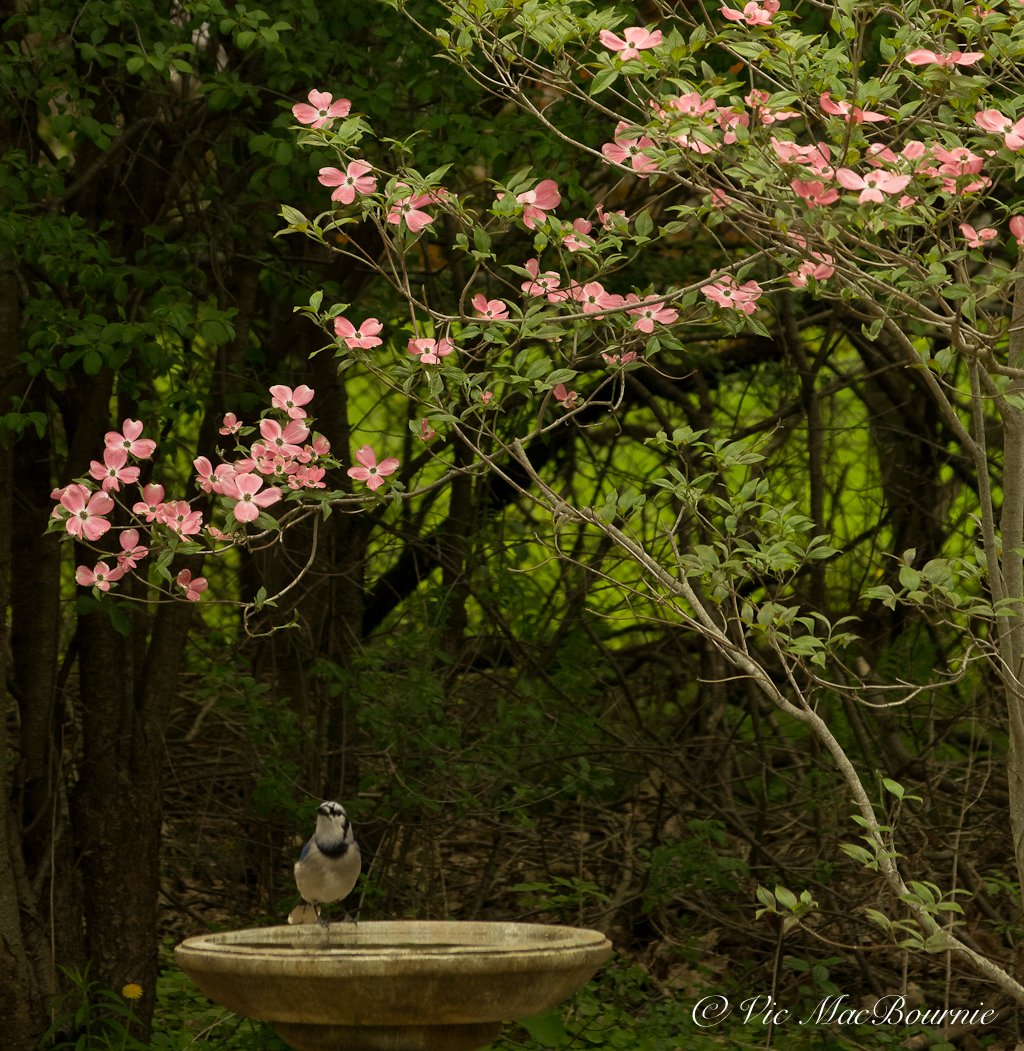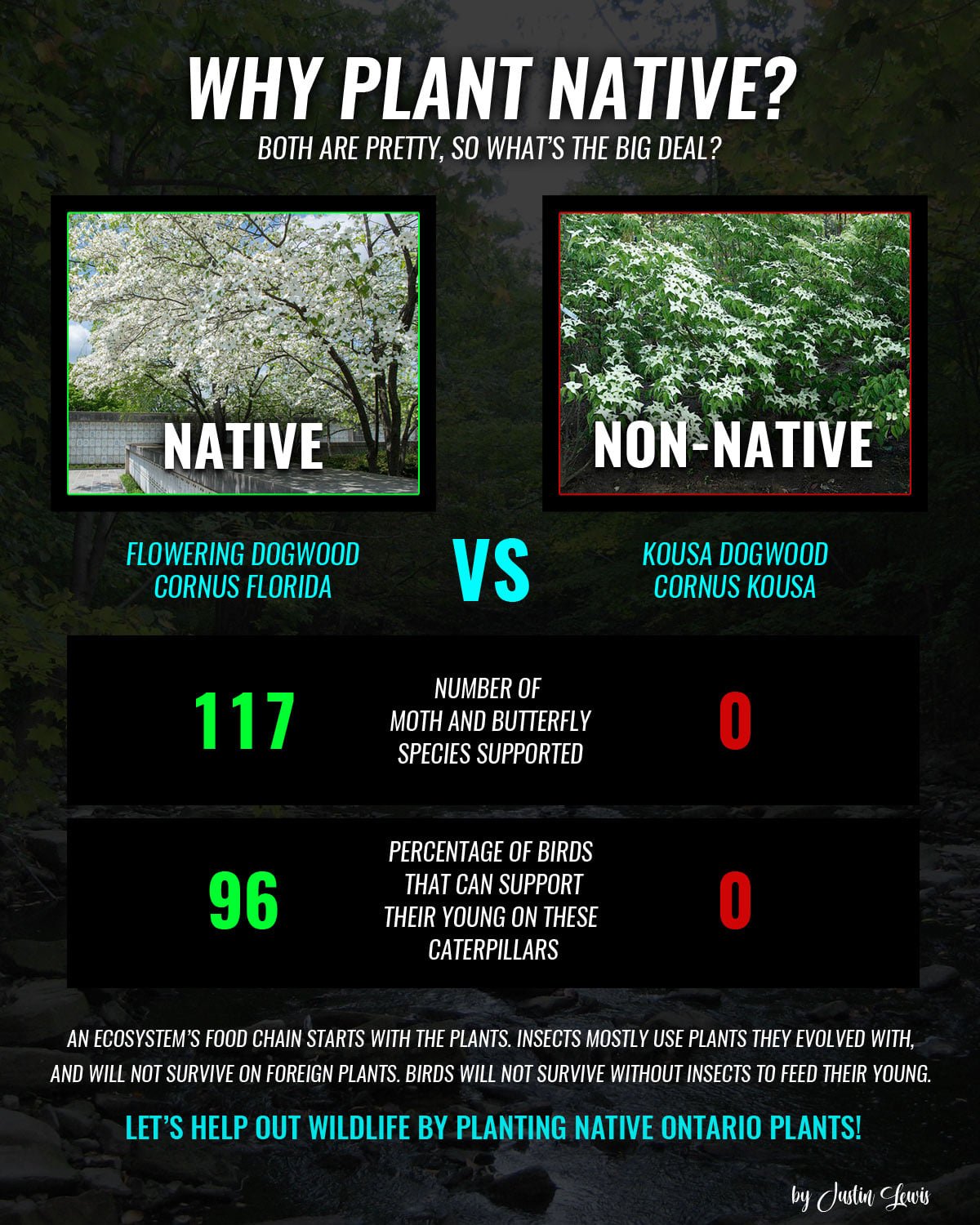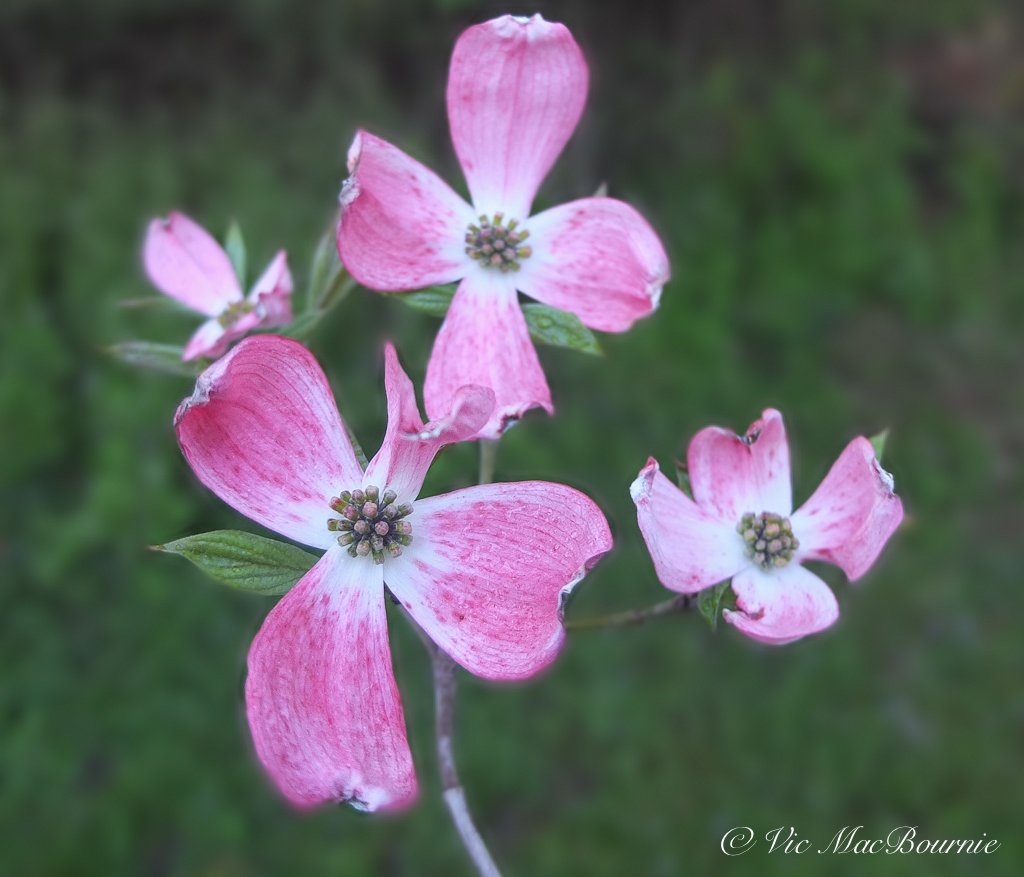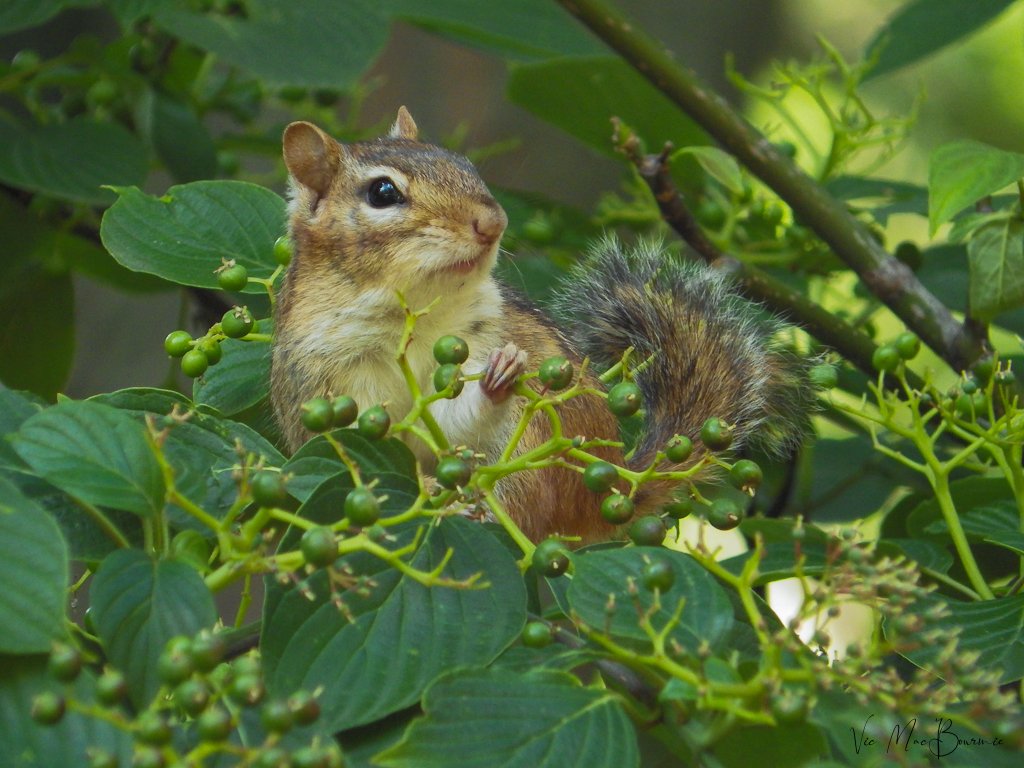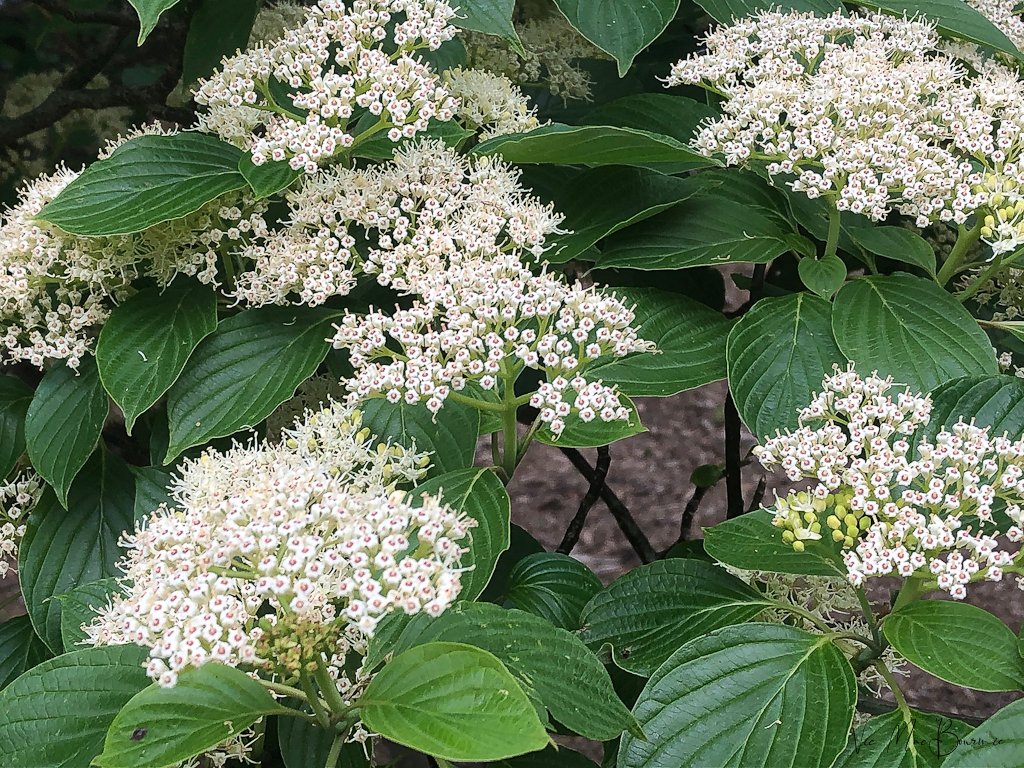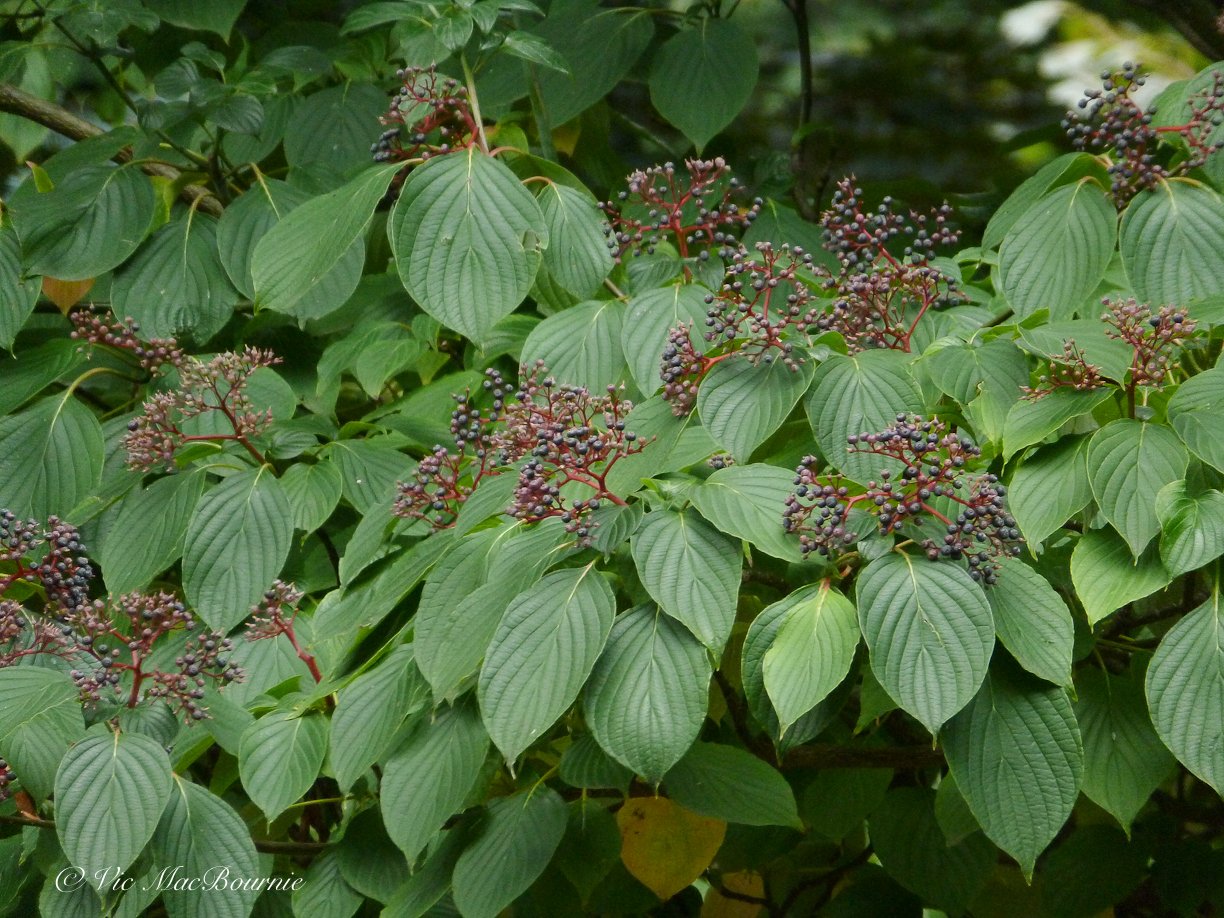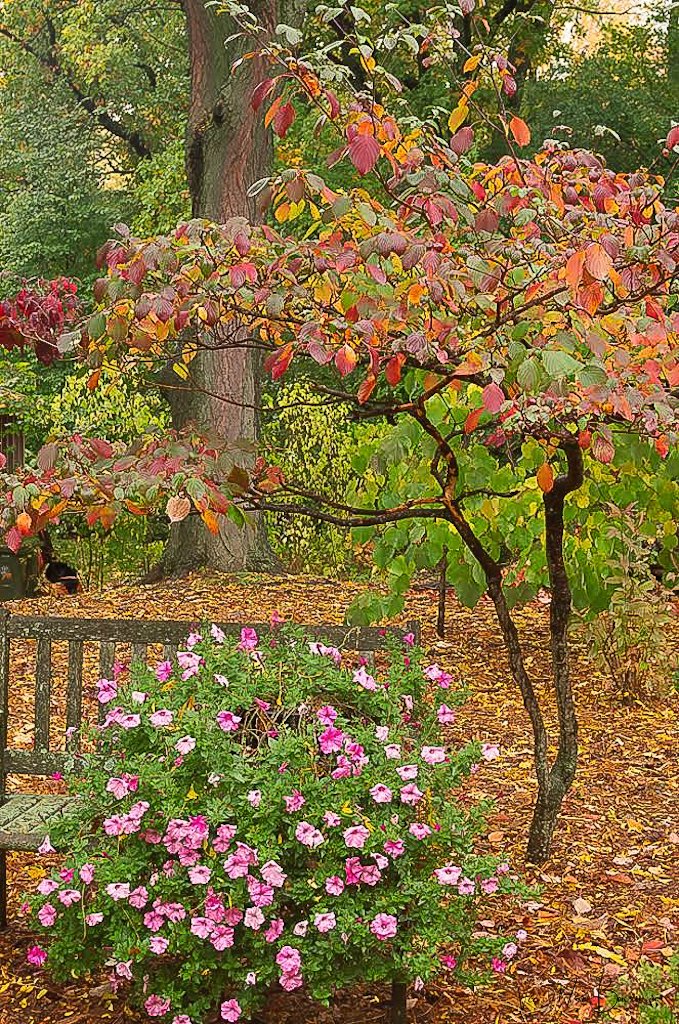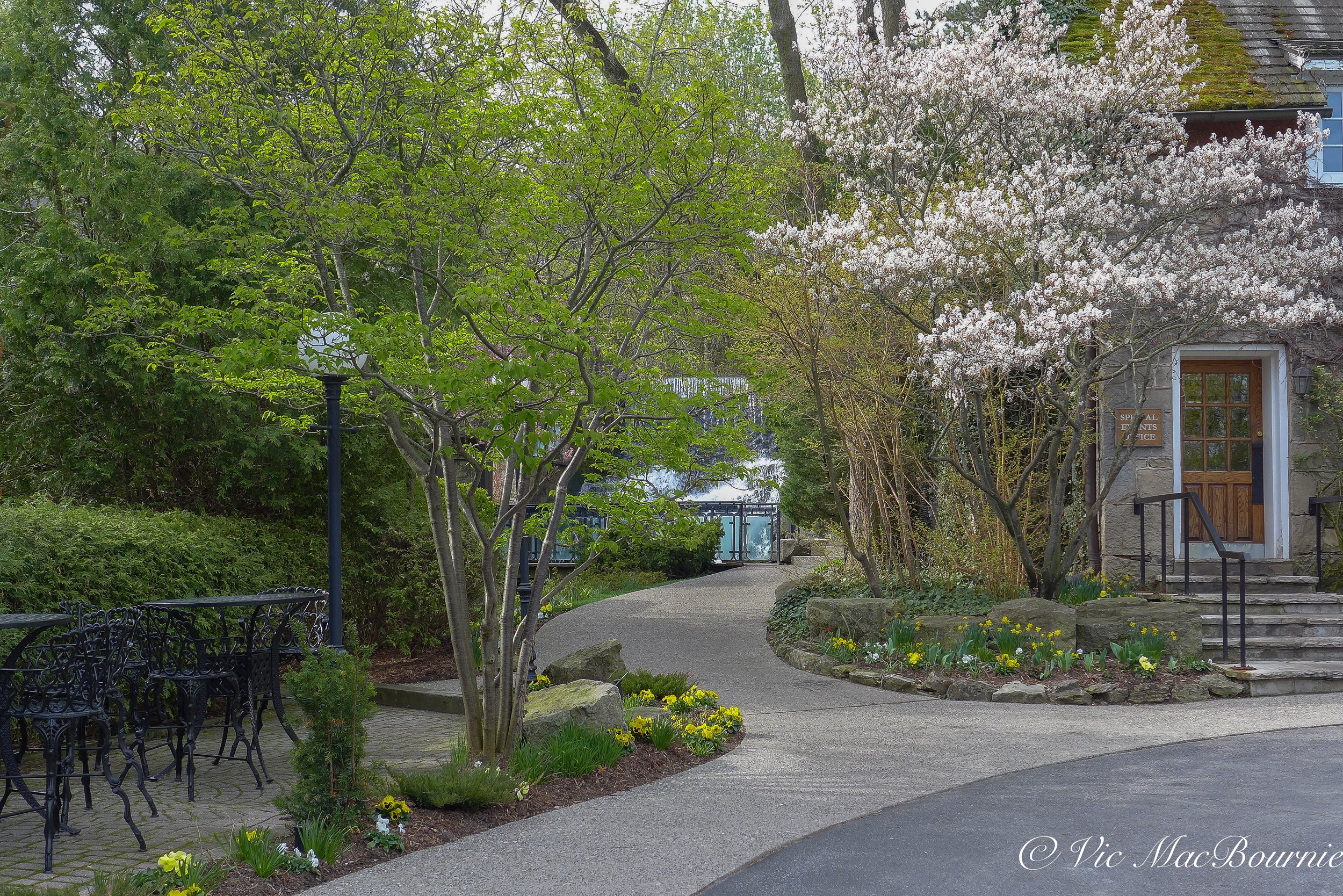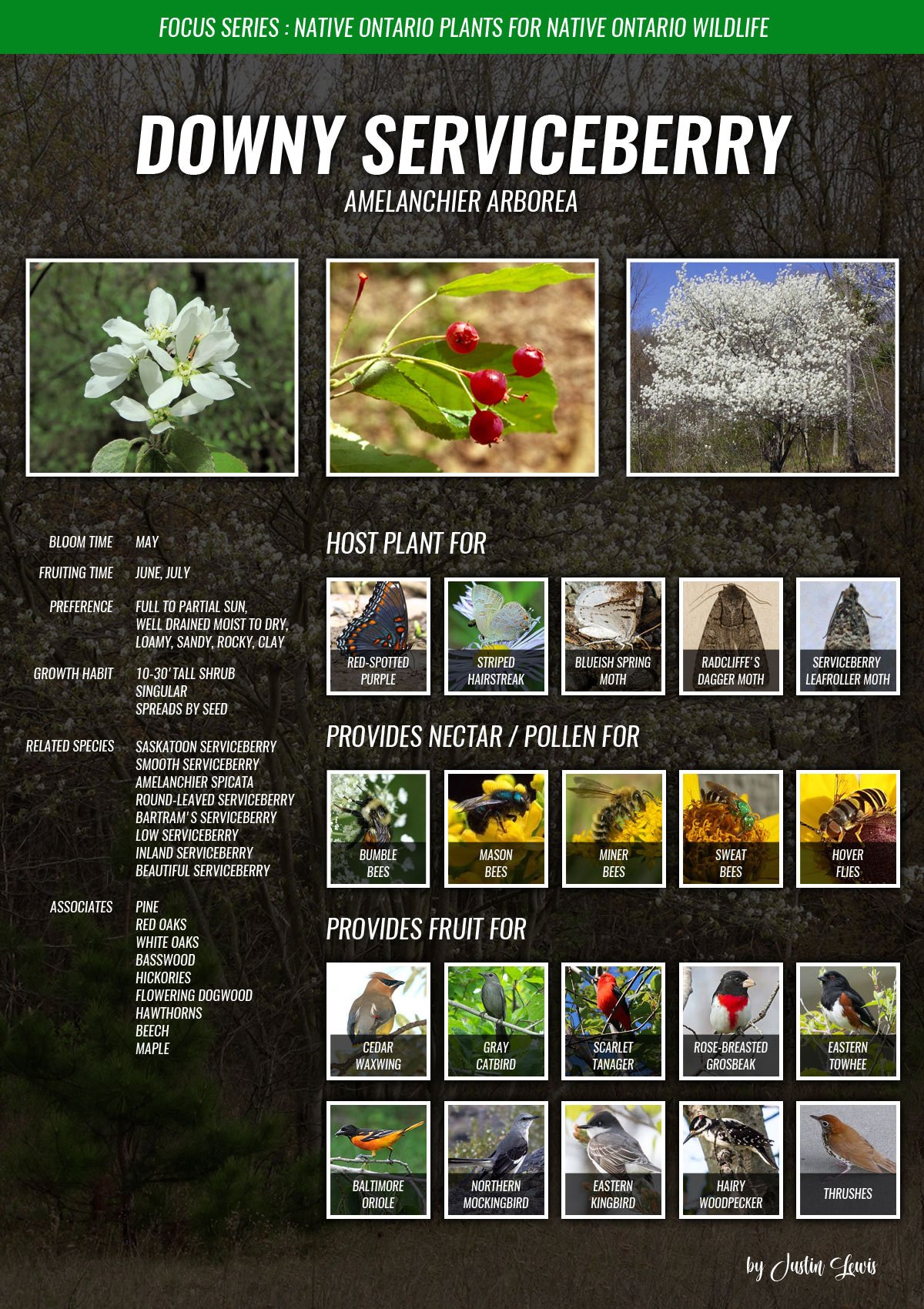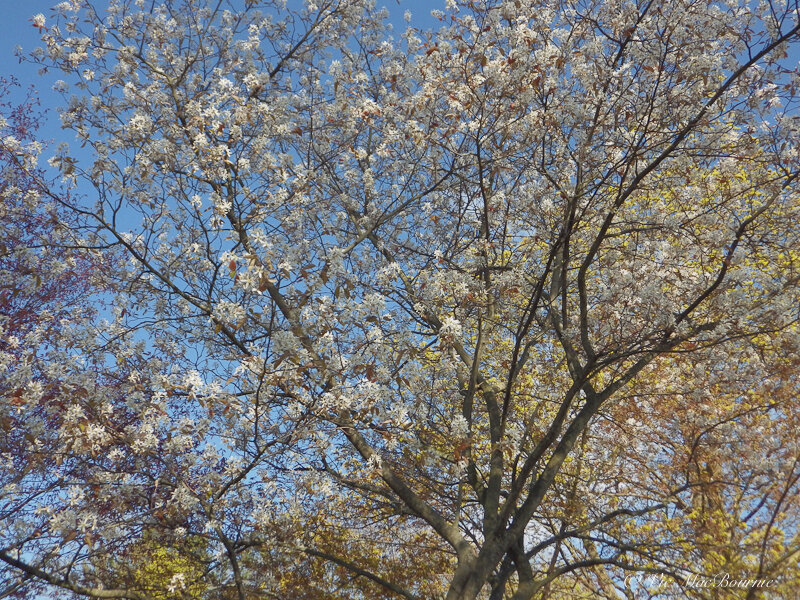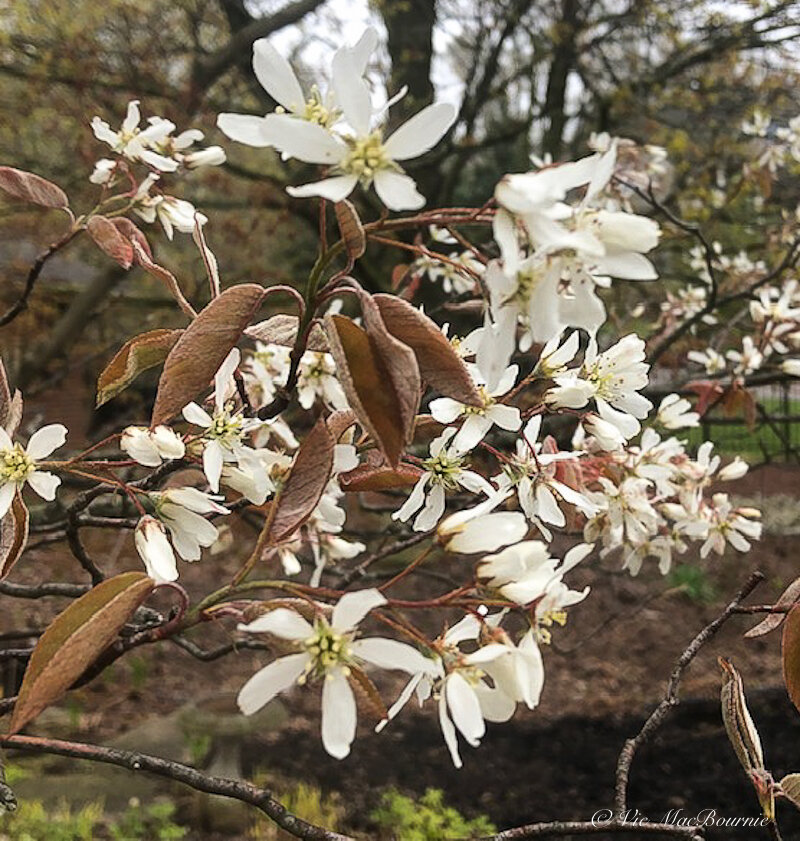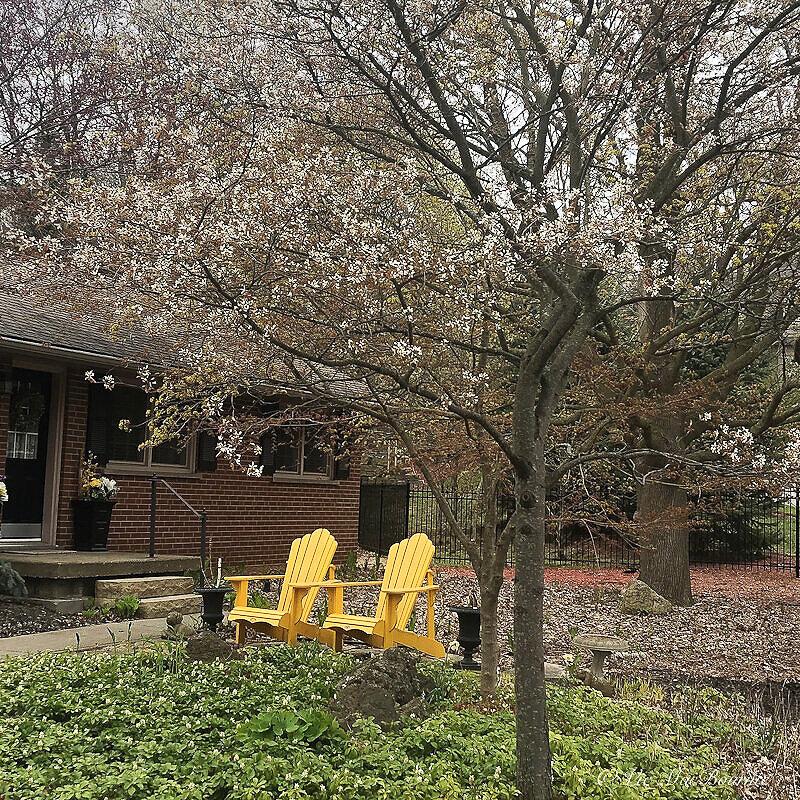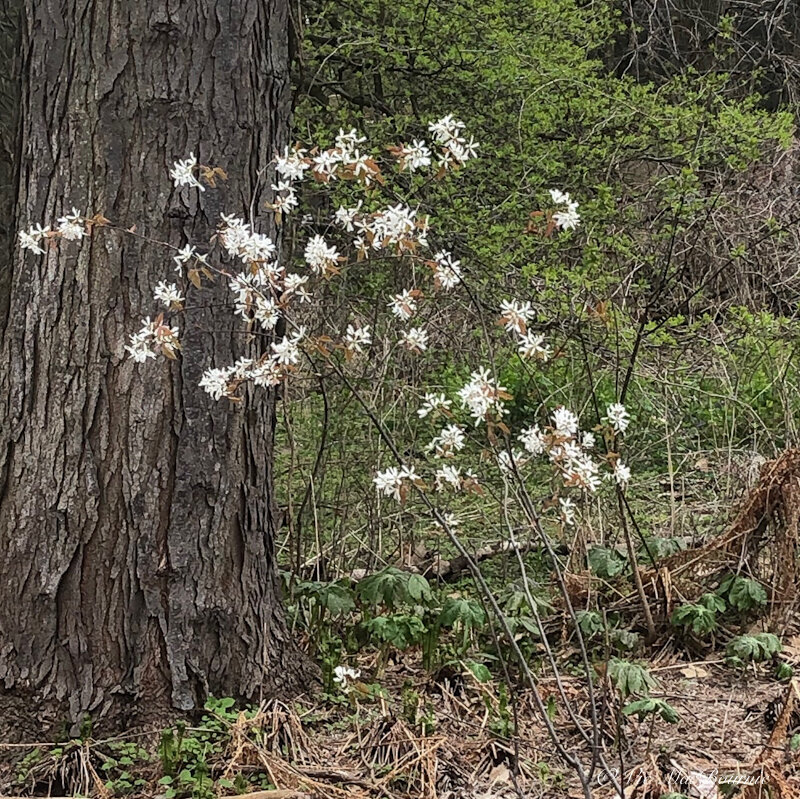Flowering Dogwood: The queen of the Woodland garden
The flowering dogwood is an icon of the American landscape with its spectacular spring flowers followed by red berries that birds cannot get enough of as they ripen.
The Flowering Dogwood (Cornus Florida) combines everything a gardener could want in a backyard tree.
If you are lucky enough to live in a region where you can grow this iconic native American flowering tree, whether it’s in your front as a specimen tree or as an understory tree in the backyard woodland or shade garden, you should waste no time sourcing one or even several for your front and back gardens.
In our backyard woodland garden, we have several that fill the garden with showy spring flowers followed by berries in summer and outstanding fall colour.
Its native range is New England south to northern Florida, west to the Mississippi and even beyond. In Canada it finds its range in Southern Ontario’s Carolinian zone.
In the cooler growing zones found in Northeastern U.S. and parts of Canada in zones 5-6 for example, Dogwoods can take more sun than the hotter zones farther south where they are best grown in light to partial shade.
Travelling through the Great Smokey Mountains and along the Blue Ridge Parkway in early spring is perhaps the ideal way to experience magnificent Flowering Dogwood and Redbuds both in full bloom along their still-bare branches.
The Flowering Dogwood grows to about 30-35-feet tall in the wild (often smaller in gardens) with a spread that is about two-thirds or almost equal to its height. It’s a wide spreading mounding tree with branches that can droop right to the ground if left to grow naturally. It likes to grow in partial shade to full sun and prefers moist to dry woodsy loam to a clay-loam.
Flowering Dogwoods flowers from March, April and May followed by clusters of 3-5 red berries (or drupes) from August through October – that are highly favoured by birds and other mammals. It is the queen of the Carolinian forest and and is at home growing in zones 2 through 9. Its mottled bark creates winter interest to the already elegant, horizontal branching of our native tree.
Be sure to check out my extensive article on the Six Best Dogwoods for the Woodland Garden.
More of my posts on Dogwoods
For more information on Dogwoods, please check out my other posts listed here:
Dogwoods: Find the perfect one for your yard
Cornus Kousa: Impressive non-native for the woodland garden
Bunchberry: The ideal native ground cover
Pagoda Dogwood: Small native tree ideal for any garden
Cornus Mas: An elegant addition to the Woodland Garden
The tree’s branching habit of stretching right to the ground suggests that it wants to protect its roots from harsh sun and other root-zone incursions, so it’s a good idea to provide some protection around the tree’s root zone.
A heavy mulch around the root zone will help to hold moisture as well as protect it from direct sun and the damage lawnmowers create when working closely to the tree’s trunk. Do not pile the mulch up around the trunk of the tree. Leave a well stretching several inches to a foot or two around the tree to limit disease and insects.
Our native dogwoods do suffer from disease including Anthracnose, which can take root after a long rainy, cool spring. Anthracnose can attack the flowers and leaves of the tree all summer long and, can eventually kill the tree if it persists for several seasons.
If planted in a location, preferably as an edge-of-the-woods tree, where it gets morning sun to burn off the moisture and dew from the flowers and leaves, Anthracnose is unlikely to be a problem. Ideally, the tree should be planted where it can get afternoon shade to help it escape the extreme heat.
The Flowering Dogwood has dark red to purple fall colour. In spring it makes a great companion for Witchhazel, Redbud and serviceberries as well as the non-native asian relative the Cornus Kousa.
Cherokee Chief is a particularly nice cultivar with a pinkish flowers colour. Some cultivars are available with a darker red colour but the native still stands out best with its white to cream-coloured flowers.
What’s the difference between Cornus Florida and Cornus Kousa?
It’s important to note that the native Flowering Dogwood is not the same as the non-native Cornus Kousa, which is a popular dogwood sold at many local nurseries.
Although the two understory trees share many similarities – including large white flowers followed by red fruit – their differences are so widespread that they are really not interchangeable in the landscape.
Where they do stand out in the landscape is when you can combine them for early spring flowering in the native dogwood, through summer and late summer flowering by the non-native Cornus Kousa. The combination brings the woodland to life in an elegant display of gorgeous dogwood blooms that last almost throughout the gardening season.
• Where the native dogwood flowers in spring into early summer, the Cornus Kousa flowers pick up where the native ones begin to die out and offers flowers into late summer.
• Where native dogwood flowers grow more or less on bare branches that really show off the flowering bracts, Cornus Kousa flowers later in summer after the leaves fill out on the tree providing a beautiful showing but not quite as impressive as that offered by the native Flowering Dogood.
•Where native dogwood’s fruit is more like a drupe in clusters of 3-5, Cornus Kousa tends to put out singular fruits that look like raspberries.
• Where native dogwoods grow in a mounding, horizontal habit, Cornus Kousa tends to grow in a vase shape that eventually sends out horizontal branching if left untrimmed.
• Where the native dogwood is susceptible to disease and deer predation, Cornus Kousa, is more or less free of these problems including Anthracnose.
• Where the native dogwood is a magnet for local wildlife both as a host plant for larvae and insects through to providing an excellent food source for birds and other mammals, Cornus Kousa is neither a host plant for native caterpillars and insects, nor are its berries a great source of food for birds. Some birds and mammals (Squirrels and chipmunks) will eat the fruit but its certainly not their first choice.
• Cornus Florida supports up to 117 moths and butterflies, whereas Cornus Kousa is not known to support any in the larval stage.
• Cornus Florida also supports close to 100 birds from caterpillars that use the tree as a food source, while Cornus Kousa is not known to support any birds as a larval host.
How to water a Dogwood tree
Since the dogwood grows in a very horizontal fashion it has a very wide “drip zone.” And, because this drip zone extends out so far from the trunk of the tree, it serves little to no purpose watering the tree close to its trunk.
Look up to establish how far the tree’s branches stretch out from the main trunk and use that as your watering zone for the tree. Slow, deep waterings are necessary to keep the soil around the tree’s roots cool and moist. An all-day drip being moved around a mature tree throughout the day would be ideal during hot, dry periods with low rainfall.
Smaller, or newly planted trees would need less watering, but be sure to water deeply around the entire perimeter of the tree.
How to prune a flowering dogwood
The dogwood is a slow growing tree that tends to self prune over time. Deadwood can be cut out as it appears, but it’s important to maintain the tree’s elegant horizontal branching habit rather than try to shape it into something it does not want to be.
If grass is growing under the tree (never a great idea, better to have either living, or bark mulch), it’s best to limb up the tree as it grows and then maintain it by pruning the trees outer branches lightly to reduce the weight of the branches laden with flowers.
Try not to heavily prune the tree by taking out large branches because you will be removing the best attributes of the tree – primarily its spring flowers. It is best to just remove the smaller outer branches to reduce the weight and thus help to keep the skirt of the tree high enough to walk under.
I always prefer, if possible, to plant the tree in an area where it can take on its natural shape and not be severely pruned up.
If you are unsure how to get the most out of your dogwood, it’s probably best to hire a well-respected pruning expert to maintain the shape of these trees. Ensure the tree company is familiar with pruning ornamental trees and not just one that specializes in removing trees or large dying branches.
Pagoda Dogwood: Shade-loving native tree for woodland, wildlife
The Pagoda Dogwood or Cornus Alternifolia is a small native tree or shrub that is perfect for a woodland garden and vital to native wildlife, including birds, caterpillars, insects and mammals. It’s also an elegant, multi-layered tree with a beautiful horizontal habit that works as well in a woodland garden as it does in a Japanese inspired garden.
My love affair with dogwoods actually had its roots not with the showy Flowering Dogwood, but with a lesser known native dogwood – Cornus Alternifolia.
You may know it as Pagoda Dogwood or Alternate-Leaved dagwood if you know it at all. Trust me, if you don’t already know about Cornus Alternifolia, you need to get to know this outstanding little gem of a dogwood. My first experience with it was in our previous home where I planted it outside the office window where I could admire it and its avian visitors spring, summer, fall and throughout the winter.
When we moved to our current home more than 23 years ago, the first tree/shrub I planted was another Pagoda Dogwood, and it continues to impress me to this day with its longevity and strong presence in the garden throughout the seasons.
Be sure to read my article on six of the best native dogwoods.
The native to the Carolinian forest is not always the showstopper, taking a back seat to the more showy Flowering Dogwood, but it’s like a younger sibling fighting hard to unseat Cornus Florida for top spot in the forest.
Cornus Alternifolia (Pagoda Dogwood) is a semi-colonizing 25-foot tall shrub or tree with a strong horizontal layering habit, that spreads by both seeds and layering. It grows in partial shade to full sun in moist, well-drained rich loamy, slightly acid soil.
This little chipmunk wasn’t waiting around for the birds to help themselves to the berries of the Pagoda Dogwood in the backyard. She searched out the ripened blackish berries as soon as they were ready for eating.
How big do Pagoda Dogwoods get?
Cornus Alternifolia or Pagoda Dogwood is a small tree or shrub reaching anywhere from 15-25 feet tall with an impressive spread of between 12 to about 32 feet.
Is the Pagoda native to areas of Ontario and the United States?
It’s native to Ontario and Northeastern United States and elsewhere including parts of the upper Midwest and even into parts of Minnesota.
How can you tell a Pagoda Dogwood?
In nature, you can spot a Cornus Alternifolia by its characteristic horizontal branching habit, creamy umbrel-style flowers, black berries and deeply veined, ovate leaves that turn a lovely shade of redish, orange in fall. Also, its Latin name is derived from the alternate position of the leaves on the stems.
Without a doubt, however, its most impressive feature is its truly elegant horizontal branching habit that gives the tree its beautiful shape in the woodland garden and makes it a valuable addition to a Japanese-style garden.
More of my posts on Dogwoods
For more information on Dogwoods, please check out my other posts listed here:
Dogwoods: Find the perfect one for your yard
Flowering Dogwood: Queen of the Woodland garden
Cornus Kousa: Impressive non-native for the woodland garden
Our Pagoda Dogwood in full bloom. Each of these florets will form berries that are particularly attractive to a host of birds from Bluebirds to Cardinals. The berries start off green and eventually turn a blackish-blue as they ripen.
When does the Pagoda Dogwood flower and produce berries
The Pagoda Dogwood’s creamy, umbrel-like flowers bloom from May through July depending on location, followed by clusters of black fruit in July that attract a host of birds from the Eastern Bluebird to Scarlet Tanagers just to name a few. Chipmunks and red squirrels are also regular visitors and will strip the berries as fast as they ripen.
Pagoda Dogwood berry clusters are loved by both birds and chipmunks in our yard.
What is a Pagoda Dogwood’s Lifespan?
Our original Cornus Alternifolia is still doing well after more than 23 years in the garden. It’s no surprise that it is still gracing our woodland considering the longevity of these tough little trees. Pagoda Dogwoods can live between 50 - 150 years old so there is a good chance it will still be around for a few years yet. A second Pagoda Dogwood was planted a few years ago in the understory of two very old crabapple trees located not too far from the original Pagoda.
What birds are attracted to the Pagoda Dogwood?
The list of avian visitors is almost endless and include the highly sought after Eastern Bluebird, a variety of Vireos and Thrushes as well as Cedar Waxwings, Gray Catbirds, Cardinals, Scarlet Tanagers, Eastern Kingbirds, Rose-Breasted Grossbeaks and Yellow-Bellied Sapsucker.
Our original 23-year-old Pagoda Dogwood in spring bloom showing off its multitude of blooms. The umbrel-type, creamy flowers are not the show stoppers of the more showy Flowering Dogwoods, but they hold their own in the woodland as a lovely understory tree.
The same 23-year-old Pagoda Dogwood in its fall coat.
Is Cornus Alternifolia a host plant?
The Pagoda, like most native plants, is a host plant to a number of Lepidoptera (caterpillars or larvae of moths and caterpillars) including: The Fragile Miner Bee, Summer Azure butterfly, the impressive Cecropia Moth, Fragile White Carpet Moth and Unicorn Caterpillar.
What Native bees does Cornus Alternifolia attract?
The spring and summer flowers provide nectar and pollen for a number of our native bees including: The bright flourescent Sweat Bees, Miner Bees, Masked Bees and Hover Flies.
What other species is the Pagoda Dogwood related to:
Dogwoods represent a large species ranging from the impressive and equally beautiful Flowering Dogwood (Cornus Florida) to the diminutive Bunchberry (Cornus Canadensis) with its familiar dogwood flowers in minature form growing in large swaths as a ground cover. Other related species include: Red-Osier Dogwood, Rough-leaved, Grey, silky and Round-Leaved.
What cultivars are available for the Pagoda Dogwood?
Using the native, non-cultivar or species tree/shrub is always a solid choice if you want to attract or provide food for the largest variety of wildlife in your garden. There are, however, popular cultivars of Cornus Alternifolia if you are looking for specific traits in the plant.
Golden Shadows: This brightly-coloured variety (zones 3-8) from Proven Winners sports variegated leaves that help the plant stand out in a shady area of the garden where it reaches heights of 10-12 feet with an equal spread. The highly successful company describes the plant as: “bright yellow with a splotch of emerald green in the cenre, taking on pink tones on the new growth in cool weather. Spring sees the plant graced with lacy white blooms. Beneath all this beauty lies a tough North American native that can grow in many difficult conditions; Golden Shadows Pagoda Dogwood is especially noteworthy for its ability to thrive in light shade, its bright foliage bringing colour and beauty to otherwise dim sites.”
C. alternifolia 'Argentea' is known as silver pagoda dogwood and is similar to Golden Shadows but sports a green and white variegation rather than the green and gold.
Cornus controversa: Sometimes called the Wedding Cake Tree, it is a spectacular, extremely showy giant pagoda dogwood with a mature height of 60 feet. When this tree is in flower it is simply a spectacular site. Grows in zones 6-9 and is the winner of the prestigious Award of Garden Merit from the Royal Horticultural Society.
Serviceberry: Ideal choice for attracting birds
More native plant gardeners are discovering the incredible value of the Serviceberry tree or shrub. A flush of delicate white flowers that cover the native trees and shrubs in early spring, followed by a profusion of deep red/purple berries creates a magnet for birds, bees and other wildlife. It’s the perfect understory tree for any woodland wildlife garden.
A beautiful multi-stem serviceberry in full bloom in early May. The lovely white flowers will be replace by juicy dark fruits that wildlife, especially berry-eating birds and chipmunks.
A magnet for Robins, Orioles and Cardinals
Looking for the perfect small native tree for your yard? Look no further than the Serviceberry tree.
In my garden these understory trees are a staple, together with dogwoods. My first was a single stem small tree that I planted in the front of the house close to 20 years ago. Since then I have planted several in the backyard, including multi-stem versions and a hybrid columnar form.
Amelanchier species can be grown as an understory tree or in shrub form and is hardy from zones 4 -9. Its delicate white sprays of flowers cover the trees in early spring (usually the first week of May where I live) and soon give way to massive amounts of juicy deep red/purple pome berries in June that are magnets to a host of birds, squirrels and chipmunks.
For my article on why native plants, shrubs and trees are important, go here.
Also known as juneberries, shad-blow, shadbush and Saskatoon berries, Amelanchier Canadensis is a member of the rose family. Both A. Canadensis and A. arborea are native to eastern North America ranging from Newfoundland west to southern Ontario and in the United States from Maine to the Carolinas.
Most of the trees and shrubs stay compact from about 6 feet in shrub form to about 25 feet tall in tree form, and are among the first to bloom in the spring woodlands providing important nectar and food sources for early emerging insects and pollinators including many native bees.
In the United States, the common serviceberry tree which is native to to the midwestern and eastern U.S. can grow to an impressive 40 feet tall in moist soil. It is a a wildlife favourite with more than 40 species of birds consuming the fruit including the cedar waxwing, eastern towhee and Baltimore oriole.
5 reasons to plant a serviceberry
• They are tough, adaptable small trees or shrubs that do well in most conditions
• Their spring flowers are among the earliest making them important native plants for early pollinators, including native bees
• Their fruit attracts a range of birds including robins, cardinals and orioles.
• They are native to Canada and the United States and an important addition to any woodland wildlife garden
• They are a host plant to butterflies and a food source for mammals
Poster created by Justin Lewis. Best viewed on tablet or desktop.
The spring bloom of the amelanchier is followed by the multitude of berries (similar to blueberries in size and flavour but sweeter) just in time to feed young birds that have fledged the nest and are looking for a good meal. Robins are often among the first to find the berries followed by orioles, thrushes, woodpeckers and cedar waxwings just to name a few.
Don’t be surprised if robins and cardinals decide to nest in the thick branches of the serviceberry.
Serviceberries trees are also important plants of the larvae of some of our favourite butterflies including tiger butterflies, viceroys and admirals.
Serviceberry flowers in full bloom from our 20-year-old tree in our front yard lights up the landscape for a few weeks in early May. The abundance of flowers will soon become berries to feed birds and other fauna.
If you garden in more remote areas, you can expect moose, deer, and other animals to browse on the leaves and twigs of the plant. The berries are also a favourite of chipmunks, squirrels and even the wily fox.
In Canada alone there are 24 species of Amelanchier that includes some varieties and some hybrids that are common in the wild. In fact Canada is a hot spot for Amelanchier diversity, potentially sporting the greatest variety in the world. Canada’s east coast boasts several including some that are quite rare (A. gaspensis and A nantuckitensis) and do not grow wild in Ontario.
The flowers of our Serviceberry in early spring. Notice that the flowers have emerged before the leaves are fully out.
The U.S. also has a few more species that are not in Ontario. All of the species share similar attributes including white flowers, gray bark and red/purple berries.
Most of these species are not grown in nurseries. In fact, most of the serviceberries seen at garden centres focus on four species – A. canadensis, A. alnifolia, A laevis and A. grandiflora.
Autumn Brilliance, a very popular nursery-grown hybrid serviceberry, is from the grandiflora species.
The many forms of wild serviceberry (Amelanchier) help illustrate their importance to native wildlife. Each flower has five long bright white petals. The flowers that bloom anywhere from March to June, depending on the species, usually grow in clusters at the end of new growth.
In Canada alone there are several forms from Amelanchier alnifolia that is native to parts of Ontario, British Columbia, Yukon and North West Territories. It grows up to three metres and can form large thickets. The flowers often precede the leaves and the fruit of this Saskatoonberry or western serviceberry is said to be the sweetest and juiciest of all the Canadian Amelanchiers.
A serviceberry in full bloom is the perfect understory tree in a woodland wildlife garden.
Amelancheir Arborea, (Link to Lady Bird Johnson Wildflower centre) also known as the Downy serviceberry or juneberry or common serviceberry is native to southern Ontario and southern Quebec where it is easily identified in spring bloom growing along forest edges and clearings often in dry soil, rocky or sandy areas. Downies grow most often as a small tree with leaves that are tapered to a point and are hairy when they are opening – which is where they pick up the name Downy.
A shrub form of the serviceberry shows off its incredible blooms that will later become a profusion of delicious berries that birds flock will likely get before you do.
Amelanchier laevis (Link to Lady Bird Johnson Wildflower centre) or often called smooth serviceberry or allegheny serviceberry are native to Western Ontario through to Newfoundland and are found in moist woodlands, clearing and roadsides.
Amelanchier stolonifera (Link to Lady Bird Johnson Wildflower centre) is a suckering shrub that grows to only about two metres tall and spreads to form thickets. It is found in the wild along sandy and rocky areas in dry woodlands, along cliffs and dunes.
Serviceberries are not picky about soil conditions and do well in sun or part-shade conditions. In the wild it is most often found growing in wet areas but, some species can be found growing in harsh areas along granite and limestone cliffs.
If all of these highlights still has not go you convinced that a serviceberry is a must for your woodland garden, consider that its fall colours are spectacular with blazing foliage in reds oranges and yellows.
Serviceberries in our garden
In our garden we are blessed with both the tree form and a small shrub that I was lucky enough to score at our annual local horticultural society sale. I planted that a few years ago, and just this year it is really putting on a nice show in the woodland garden.
Our tree form is more than 20 years old and has matured into a beautiful specimen that puts on a magnificent show every year during the first week of May. It throws the perfect light shade on the wildflower garden below and coexists nicely with a Japanese maple. Both trees have begun to merge branches forming a lovely open canopy over the native plants below, including solomon’s seal, columbine, bloodroot, wild geranium and foamflower, and non-natives that include epimedium.
Propagating from cuttings and seed
Serviceberries are easily propagated and can be rooted from early spring hardwood cutting or softwood cuttings taken during the summer months. If you want to plant them from seeds, you are going to have to collect some berries when they begin ripening and turning red to purple. Give the seeds a quick cleaning and plant them in the fall. If you plan to grow them in trays, you will have to stratify the seeds and store them in the fridge for at least three months.
More links to my articles on native plants
Why picking native wildflowers is wrong
The Mayapple: Native plant worth exploring
Three spring native wildflowers for the garden
A western source for native plants
Native plants source in Ontario
The Eastern columbine native plant for spring
Three native understory trees for Carolinian zone gardeners
Ecological gardening and native plants
Eastern White Pine is for the birds
Native viburnums are ideal to attract birds
The Carolinian Zone in Canada and the United States
Dogwoods for the woodland wildlife garden
Bringing Nature Home by Douglas Tellamy
A little Love for the Black-Eyed Susan
Native moss in our gardens
As an affiliate marketer with Amazon or other marketing companies, I earn money from qualifying purchases.



